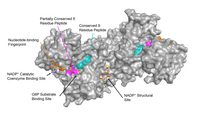
Photo from wikipedia
Stagnation in the development of new antibiotics emphasizes the need for the discovery of drugs with novel modes of action that can tackle antibiotic resistance. Contrary to humans, most bacteria… Click to show full abstract
Stagnation in the development of new antibiotics emphasizes the need for the discovery of drugs with novel modes of action that can tackle antibiotic resistance. Contrary to humans, most bacteria use the methylerythritol phosphate (MEP) pathway to synthesize crucial isoprenoid precursors. 1-deoxy-D-xylulose 5-phosphate synthase (DXPS) catalyzes the first and rate-limiting step of the pathway, making it an attractive target. Alkylacetylphosphonates (alkylAPs) are a class of pyruvate mimicking DXPS inhibitors that react with thiamin diphosphate (ThDP) to form a stable phosphonolactyl (PLThDP) adduct. Here, we present the first M. tuberculosis DXPS crystal structure in complex with an inhibitor (butylacetylphosphonate (BAP)) using a construct with improved crystallization properties. The 1.6 Å structure shows that the BAP adduct interacts with catalytically important His40 and several other conserved residues of the active site. In addition, a glycerol molecule, present in the D-glyceraldehyde 3-phosphate (D-GAP) binding site and within 4 Å of the BAP adduct, indicates that there is space to extend and develop more potent alkylAPs. The structure reveals the BAP binding mode and provides insights for enhancing the activity of alkylAPs against M. tuberculosis, aiding in the development of novel antibiotics.
Journal Title: Crystals
Year Published: 2023
Link to full text (if available)
Share on Social Media: Sign Up to like & get
recommendations!